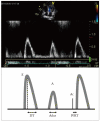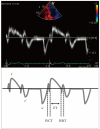Use and Limitations of E/e' to Assess Left Ventricular Filling Pressure by Echocardiography
- PMID: 22259658
- PMCID: PMC3259539
- DOI: 10.4250/jcu.2011.19.4.169
Use and Limitations of E/e' to Assess Left Ventricular Filling Pressure by Echocardiography
Abstract
Measurement of left ventricular (LV) filling pressure is useful in decision making and prediction of outcomes in various cardiovascular diseases. Invasive cardiac catheterization has been the gold standard in LV filling pressure measurement, but carries the risk of complications and has a similar predictive value for clinical outcomes compared with non-invasive LV filling pressure estimation by echocardiography. A variety of echocardiographic measurement methods have been suggested to estimate LV filling pressure. The most frequently used method for this purpose is the ratio between early mitral inflow velocity and mitral annular early diastolic velocity (E/e'), which has become central in the guidelines for diastolic evaluation. This review will discuss the use the E/e' ratio in prediction of LV filling pressure and its potential pitfalls.
Keywords: Doppler echocardiography; Echocardiography; Left ventricular filling pressure.
Figures



Similar articles
-
Airflow obstruction and left ventricular filling pressure in suspected chronic obstructive pulmonary disease.Respir Physiol Neurobiol. 2014 Feb 1;192:85-9. doi: 10.1016/j.resp.2013.12.008. Epub 2013 Dec 19. Respir Physiol Neurobiol. 2014. PMID: 24361463
-
Noninvasive assessment of left ventricular end-diastolic pressure by deceleration time of early diastolic mitral annular velocity in patients with heart failure.Echocardiography. 2017 Sep;34(9):1292-1298. doi: 10.1111/echo.13626. Echocardiography. 2017. PMID: 28929616
-
Evaluation of left ventricular filling pressures by Doppler echocardiography in patients with hypertrophic cardiomyopathy: correlation with direct left atrial pressure measurement at cardiac catheterization.Circulation. 2007 Dec 4;116(23):2702-8. doi: 10.1161/CIRCULATIONAHA.107.698985. Epub 2007 Nov 19. Circulation. 2007. PMID: 18025528
-
A Test in Context: E/A and E/e' to Assess Diastolic Dysfunction and LV Filling Pressure.J Am Coll Cardiol. 2017 Mar 21;69(11):1451-1464. doi: 10.1016/j.jacc.2016.12.037. J Am Coll Cardiol. 2017. PMID: 28302294 Review.
-
Correlation with invasive left ventricular filling pressures and prognostic relevance of the echocardiographic diastolic parameters used in the 2016 ESC heart failure guidelines and in the 2016 ASE/EACVI recommendations: a systematic review in patients with heart failure with preserved ejection fraction.Eur J Heart Fail. 2018 Sep;20(9):1303-1311. doi: 10.1002/ejhf.1220. Epub 2018 Jun 7. Eur J Heart Fail. 2018. PMID: 29877602
Cited by
-
Role of Echocardiography in Diabetic Cardiomyopathy: From Mechanisms to Clinical Practice.J Cardiovasc Dev Dis. 2023 Jan 26;10(2):46. doi: 10.3390/jcdd10020046. J Cardiovasc Dev Dis. 2023. PMID: 36826542 Free PMC article. Review.
-
3D Echocardiography - A Useful Method for Cardiovascular Risk Assessment in End-Stage Renal Disease Patients.Physiol Res. 2021 Nov 30;70(Suppl 1):S109-S120. doi: 10.33549/physiolres.934782. Physiol Res. 2021. PMID: 34918535 Free PMC article.
-
Left Atrium Measurements via Computed Tomography Pulmonary Angiogram as a Predictor of Diastolic Dysfunction.J Comput Assist Tomogr. 2017 Sep/Oct;41(5):792-797. doi: 10.1097/RCT.0000000000000597. J Comput Assist Tomogr. 2017. PMID: 28448402 Free PMC article.
-
Validating Left Ventricular Filling Pressure Measurements in Patients with Congestive Heart Failure: CardioMEMS™ Pulmonary Arterial Diastolic Pressure versus Left Atrial Pressure Measurement by Transthoracic Echocardiography.Cardiol Res Pract. 2018 Jul 15;2018:8568356. doi: 10.1155/2018/8568356. eCollection 2018. Cardiol Res Pract. 2018. PMID: 30116638 Free PMC article.
-
Utility of D-shaped Left Ventricle and Mitral E/E' in Patients with Pulmonary Hypertension.J Cardiovasc Imaging. 2018 Jun;26(2):59-60. doi: 10.4250/jcvi.2018.26.e4. Epub 2018 Jun 12. J Cardiovasc Imaging. 2018. PMID: 29971265 Free PMC article. No abstract available.
References
-
- McMurray JJ. Clinical practice. Systolic heart failure. N Engl J Med. 2010;362:228–238. - PubMed
-
- Jessup M, Brozena S. Heart failure. N Engl J Med. 2003;348:2007–2018. - PubMed
-
- Paulus WJ, Tschöpe C, Sanderson JE, Rusconi C, Flachskampf FA, Rademakers FE, Marino P, Smiseth OA, De Keulenaer G, Leite-Moreira AF, Borbély A, Edes I, Handoko ML, Heymans S, Pezzali N, Pieske B, Dickstein K, Fraser AG, Brutsaert DL. How to diagnose diastolic heart failure: a consensus statement on the diagnosis of heart failure with normal left ventricular ejection fraction by the Heart Failure and Echocardiography Associations of the European Society of Cardiology. Eur Heart J. 2007;28:2539–2550. - PubMed
-
- Liang HY, Cauduro SA, Pellikka PA, Bailey KR, Grossardt BR, Yang EH, Rihal C, Seward JB, Miller FA, Abraham TP. Comparison of usefulness of echocardiographic Doppler variables to left ventricular enddiastolic pressure in predicting future heart failure events. Am J Cardiol. 2006;97:866–871. - PubMed
-
- Kuroda T, Shiina A, Suzuki O, Fujita T, Noda T, Tsuchiya M, Yaginuma T, Hosoda S. Prediction of prognosis of patients with idiopathic dilated cardiomyopathy: a comparison of echocardiography with cardiac catheterization. Jpn J Med. 1989;28:180–188. - PubMed
LinkOut - more resources
Full Text Sources
Other Literature Sources

